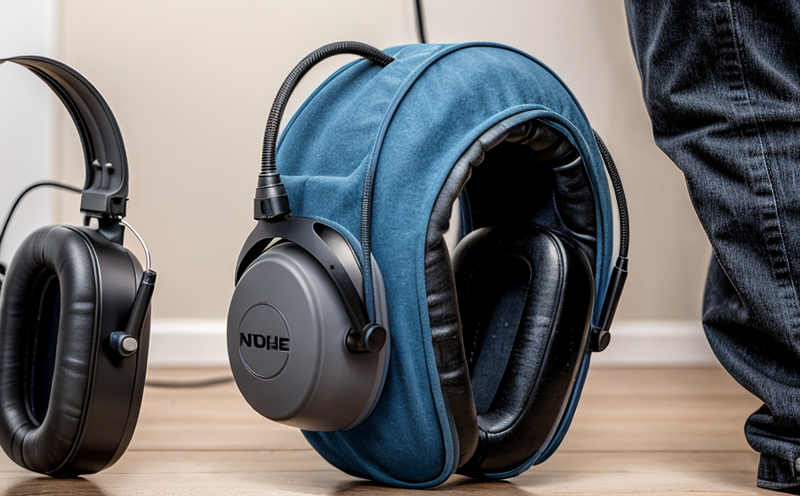ISO 4869-8 Passive Ear Defender Performance Testing
The ISO 4869 series of standards provides a robust framework for evaluating the performance and protection provided by passive ear protectors. This testing is critical in ensuring that hearing protective devices meet or exceed industry standards, thereby safeguarding workers from the detrimental effects of prolonged exposure to noise.
Passive ear defenders are designed to reduce sound levels at the eardrum, offering a first line of defense against excessive noise. The ISO 4869-8 standard specifically focuses on testing passive earmuffs and earplugs for their ability to attenuate sound pressure levels effectively. This service is essential in ensuring that these devices perform as advertised and provide adequate protection.
The test procedure involves subjecting the ear protectors to a series of noise stimuli, typically ranging from 30 dB to 120 dB (A-weighted), at various frequencies. The attenuation provided by the protector is then measured in decibels (dB) across these frequency bands. This measurement indicates how much sound reduction the device offers compared to the incident noise.
The performance of passive ear defenders is evaluated using several key metrics, including overall attenuation, low-frequency attenuation, and high-frequency attenuation. These metrics are crucial for understanding not only the overall protection level but also the specific frequency ranges where the protector performs best or worst. This information is vital for selecting the appropriate protector based on the noise environment encountered by workers.
The standard requires that passive ear defenders demonstrate a minimum of 25 dB of overall attenuation across all tested frequencies to be considered compliant with ISO 4869-8. However, in real-world applications, higher levels of attenuation are often desirable for more noisy environments. Compliance testing ensures that the devices meet these minimal requirements while also providing detailed performance data for informed decision-making.
The testing process involves precise calibration of noise sources and measurement equipment to ensure accurate results. This includes using an anechoic chamber or a reverberation room, depending on the specific test requirements. The use of standardized noise stimuli allows for consistent and repeatable measurements across different devices and laboratories.
| Item | Description |
|---|---|
| Noise Source | Calibrated white noise generator with a frequency range of 10 Hz to 20 kHz. |
| Measurement Microphones | High-sensitivity, omnidirectional microphones placed at the ear canal entrance. |
The testing process also involves careful preparation of the test specimens. This includes ensuring that the earmuffs or earplugs are worn correctly and securely to mimic real-world use conditions as closely as possible. Any deviation from standard wear could lead to inaccurate attenuation measurements.
Once the tests are completed, detailed reports are generated summarizing the performance metrics of each device tested. These reports provide a comprehensive overview of the protector's effectiveness across all relevant frequency bands and noise levels. This information is invaluable for quality assurance departments, R&D teams, and procurement personnel to make informed decisions about selecting appropriate hearing protection.
Scope and Methodology
| Parameter | Description |
|---|---|
| Noise Levels | Tests conducted at 30 dB to 120 dB (A-weighted) across multiple frequency bands. |
| Attenuation Measurement | Determination of the reduction in sound pressure level provided by the ear protector. |
The methodology for ISO 4869-8 Passive Ear Defender Performance Testing involves a series of standardized procedures to ensure accurate and consistent results. The testing begins with calibrating the noise sources and measurement equipment. This ensures that all measurements are taken under controlled conditions, minimizing any variability in the results.
The earmuffs or earplugs are then placed on the dummy head used for these tests. The dummy head is designed to mimic human anatomy as closely as possible, including the shape of the head and the placement of the ears. This allows for more accurate measurements of the protector's effectiveness in real-world scenarios.
The noise stimuli are then applied at various frequencies and intensities. The attenuation provided by the ear protectors is measured using high-sensitivity microphones placed at the ear canal entrance. These measurements provide a detailed picture of how well the device attenuates sound across different frequency bands.
Why Choose This Test
- Ensures compliance with international standards for hearing protection devices.
- Provides accurate and reliable measurements of attenuation performance.
- Aids in selecting the most effective ear protectors for specific noise environments.
- Supports quality assurance programs by identifying potential issues early.
- Facilitates ongoing development and improvement of hearing protection devices.
Quality and Reliability Assurance
The ISO 4869-8 Passive Ear Defender Performance Testing service is designed to uphold the highest standards of quality assurance. By adhering strictly to the procedures outlined in this international standard, we ensure that every test conducted meets rigorous scientific criteria.
Our laboratory uses state-of-the-art equipment and follows strict calibration protocols to maintain accuracy. This commitment to precision allows us to provide reliable data that can be trusted by clients across various industries. Regular audits and quality checks further reinforce our dedication to excellence in testing services.
We also offer ongoing support to help clients interpret the results of these tests. Our experienced technical staff can assist with understanding the implications of test outcomes, offering guidance on selecting appropriate hearing protection for specific applications.





